Majorana publishes results in 'Physical Review Letters'
Press release media
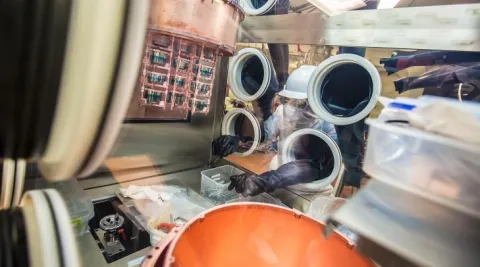
John Wilkerson installs the germanium detector strings into the cryostat. Each string shown here includes four detectors. Photo by Matthew Kapust
By Dawn Levy, Oak Ridge National Laboratory
If equal amounts of matter and antimatter had formed in the Big Bang more than 13 billion years ago, one would have annihilated the other upon meeting, and today’s universe would be full of energy but none of the matter needed to form stars, planets, and life.
That means the very existence of matter suggests something is wrong with Standard Model equations describing symmetry between subatomic particles and their antiparticles.
In a study published March 26 in Physical Review Letters, nuclear physicists from several institutions working on the Majorana Demonstrator experiment have shown that they can shield a sensitive, scalable, 44-kilogram germanium detector array from background radioactivity. The experiment is led by Oak Ridge National Laboratory (ORNL).
This accomplishment is critical to developing and proposing a much larger future experiment – with approximately a ton of detectors – to study the nature of neutrinos. These electrically neutral particles interact only weakly with matter, making their detection exceedingly difficult.
“The excess of matter over antimatter is one of the most compelling mysteries in science,” said John Wilkerson of ORNL and the University of North Carolina, Chapel Hill. Wilkerson leads the Majorana Demonstrator, which involves 129 researchers from 27 institutions and 6 nations. “Our experiment seeks to observe a phenomenon called ‘neutrinoless double-beta decay’ in atomic nuclei. The observation would demonstrate that neutrinos are their own antiparticles and have profound implications for our understanding of the universe. In addition, these measurements could provide a better understanding of neutrino mass.”
Sanford Underground Research Facility built the laboratory space that houses the experiment and provides support for the daily operations. Majorana, the first physics experiment to begin operations on the 4850 Level, began growing ultrapure copper for its highly sensitive experiment in 2011.
“This is great news for the Majorana Demonstrator collaboration,” said Mike Headley, executive director for South Dakota Science and Technology Authority and laboratory director for Sanford Lab. “Their trust in us helped lead the way for us to become a world-class physics research facility.”
Headley noted that Sanford Lab Staff members are responsible for helping with daily logistics that keep the experiment clean and running. “I’m very proud of the work this team has done to help Majorana reach this major milestone.”
In a 2015 report of the U.S. Nuclear Science Advisory Committee to the Department of Energy and the National Science Foundation, a U.S.-led ton-scale experiment to detect neutrinoless double-beta decay was deemed a top priority of the nuclear physics community. Nearly a dozen experiments have sought neutrinoless double-beta decay, and as many future experiments have been proposed. One of their keys to success depends on avoiding background that could mimic the signal of neutrinoless double-beta decay.
That was the key accomplishment of the Majorana Demonstrator. Its implementation was completed in South Dakota in September 2016, nearly a mile underground at the Sanford Underground Research Facility. Siting the experiment under nearly a mile of rock was the first of many steps collaborators took to reduce interference from background. Other steps included a cryostat made of the world’s purest copper and a complex six-layer shield to eliminate interference from cosmic rays, radon, dust, fingerprints and naturally occurring radioactive isotopes.
“If you’re going to search for neutrinoless double-beta decay, it’s critical to know that radioactive background is not going to overwhelm the signal you seek,” said ORNL’s David Radford, a lead scientist in the experiment.
There are many ways for an atomic nucleus to fall apart. A common decay mode happens when a neutron inside the nucleus emits an electron (called a “beta”) and an antineutrino to become a proton. In two-neutrino double-beta decay, two neutrons decay simultaneously to produce two protons, two electrons and two antineutrinos. This process has been observed. The Majorana Demonstrator Collaboration seeks evidence for a similar decay process that has never been observed, in which no neutrinos are emitted.
Conservation of the number of leptons—subatomic particles such as electrons, muons or neutrinos that do not take part in strong interactions—was written into the Standard Model of Physics. “There is no really good reason for this, just the observation that it appears that’s the case,” said Radford. “But if lepton number is not conserved, when added to processes that we think happened during the very early universe, that could help explain why there is more matter than antimatter.”
Many theorists believe that the lepton number is not conserved, that the neutrino and the antineutrino—which were assumed to have opposite lepton numbers—are really the same particle spinning in different ways. Italian physicist Ettore Majorana introduced that concept in 1937, predicting the existence of particles that are their own antiparticles.
The Majorana Demonstrator uses germanium crystals as both the source of double-beta decay and the means to detect it. Germanium-76 (Ge-76) decays to become selenium-76, which has a smaller mass. When germanium decays, mass gets converted to energy that is carried away by the electrons and the antineutrinos.
“If all that energy goes to the electrons, then none is left for neutrinos,” Radford said. “That’s a clear identifier that we found the event we’re looking for.”
[0]The scientists distinguish two-neutrino versus neutrinoless decay modes by their energy signatures. “It’s a common misconception that our experiments detect neutrinos,” said Jason Detwiler of the University of Washington, who is a co-spokesperson for the Majorana Collaboration. “It’s almost comical to say it, but we are searching for the absence of neutrinos. In the neutrinoless decay, the released energy is always a particular value. In the two-neutrino version, the released energy varies but is always smaller than for neutrinoless double-beta decay.”
The Majorana Demonstrator has shown that the neutrinoless double-beta decay half-life of Ge-76 is at least 1025 years—15 orders of magnitude longer than the age of the universe. So it’s impossible to wait for a single germanium nucleus to decay. “We get around the impossibility of watching one nucleus for a long time by instead watching on the order of 1026 nuclei for a shorter amount of time,” explained co-spokesperson Vincente Guiseppe of the University of South Carolina.
Chances of spotting a neutrinoless double-beta decay in Ge-76 are rare—no more than 1 for every 100,000 two-neutrino double-beta decays, Guiseppe said. Using detectors containing large amounts of germanium atoms increases the probability of spotting the rare decays. Between June 2015 and March 2017, the scientists observed no events with the energy profile of neutrinoless decay, the process that has not yet been observed (this was expected given the small number of germanium nuclei in the detector). However, they were encouraged to see many events with the energy profile of two-neutrino decays, verifying the detector could spot the decay process that has been observed.
The Majorana Collaboration’s results coincide with new results from a competing experiment in Italy called GERDA (for GERmanium Detector Array), which takes a complementary approach to studying the same phenomenon. “The Majorana Demonstrator and GERDA together have the lowest background of any neutrinoless double-beta decay experiment,” said Radford.
The Majorana Demonstrator was designed to lay the groundwork for a ton-scale experiment by demonstrating that backgrounds can be low enough to justify building a larger detector. Just as bigger telescopes collect more light and enable viewing of fainter objects, increasing the mass of germanium allows for a greater probability of observing the rare decay. With 30 times more germanium than the current experiment, the planned one-ton experiment would be able to spot the neutrinoless double-beta decay of just one germanium nucleus per year.
The Majorana Demonstrator is planned to continue to take data for two or three years. Meanwhile, a merger with GERDA is in the works to develop a possible one-ton detector called LEGEND, planned to be built in stages at an as-yet-to-be-determined site.
LEGEND 200, the LEGEND demonstrator and step towards a possible future ton-scale experiment, will be a combination of GERDA, Majorana and new detectors. Scientists hope to start on the first stage of LEGEND 200 by 2021. A ton-scale experiment, LEGEND 1000, would be the next stage, if approved.
“This merger leverages public investments in the Majorana Demonstrator and GERDA by combining the best technologies of each,” said LEGEND Collaboration co-spokesperson (and long-time Majorana spokesperson through last year) Steve Elliott of Los Alamos National Laboratory.
Funding came from the U.S. Department of Energy Office of Science and the U.S. National Science Foundation. The Russian Foundation for Basic Research and Laboratory Directed Research and Development Programs of DOE’s Los Alamos, Lawrence Berkeley and Pacific Northwest national laboratories provided support. The research used resources of the Oak Ridge Leadership Computing Facility and the National Energy Research Scientific Computing Center, DOE Office of Science User Facilities at Oak Ridge and Lawrence Berkeley national laboratories, respectively. Sanford Underground Research Facility hosted and collaborated on the experiment.
Sanford Lab is operated by the South Dakota Science and Technology Authority (SDSTA) with funding from the Department of Energy. Our mission is to advance compelling underground, multidisciplinary research in a safe work environment and to inspire and educate through science, technology, and engineering. Visit us at www.SanfordLab.org.
The title of the Physical Review Letters paper is “Search for Neutrinoless Double Beta Decay in 76Ge with the Majorana Demonstrator.”
The original press release can be found here.
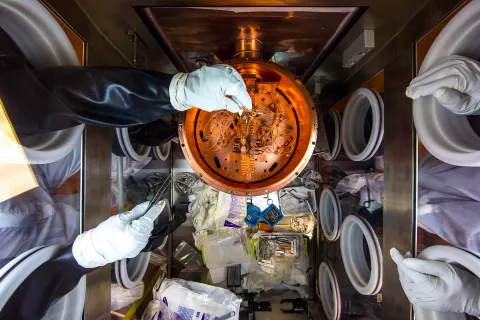
Researchers work on the delicate wiring of a cryostat, which is like a thermos under vacuum that chills the detectors that are the heart of the Majorana Demonstrator. The experiment’s 2 cryostats each house 29 germanium detectors—diodes that are reverse biased, meaning no current flows because the crystal has no free electrons or “holes” (positive charges created when electrons vacate) to allow charge movement. When a high-energy electron (a beta particle) is created during a double-beta decay, that electron will scatter off other electrons and create electron-hole pairs that move inside the germanium and create a pulse of charge inside the detector. Coaxial cables connect detectors to sensitive electronics that can measure the arrival of this tiny pulse. “Researchers amplify the pulse and measure its height and from that figure out how much energy created the electron–hole pairs,” ORNL’s David Radford said. “The number of electron-hole pairs that are created is proportional to the energy that was released.” This energy is used to distinguish if the original electrons were generated via a process that releases two neutrinos or no neutrinos. Credit: Sanford Underground Research Facility; photographer Matthew Kapust
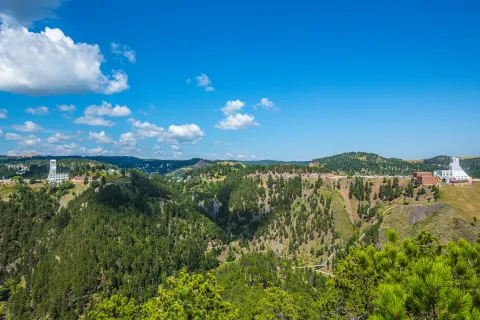
There’s scientific “gold” in them thar hills! In a South Dakota mountain, more than 370 miles of passageways were carved out in what was once the most productive gold mine in the Western Hemisphere. Today Sanford Lab maintains about 12 miles for scientific activities. The Ross Shaft headframe (left) and the Yates Shaft headframe (right) provide access to a level about 4,850 feet underground where a famous solar neutrino experiment of Ray Davis once stood. Today the Majorana Demonstrator sits around the corner from the former site of operations of the Davis Experiment, which detected solar neutrinos from 1967 to 1994 and was recognized with a share of the Nobel Prize in Physics in 2002. The Majorana Demonstrator also needs this rock to shield it from cosmic rays that could prevent researchers from spotting evidence of neutrinoless double-beta decay. Credit: Sanford Underground Research Facility; photographer Matthew Kapust
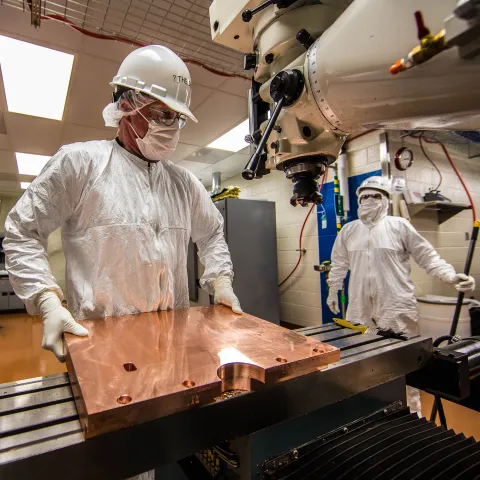
Working in a cleanroom nearly a mile underground, Randy Hughes (foreground) is the primary on-site machinist for the Majorana Demonstrator experiment. The innermost shield and detector components are fabricated from ultrapure copper produced by electroforming underground; it is much cleaner than even the cleanest commercially available copper stock. Producing and machining the copper underground prevents processes whereby cosmic rays can hit a copper nucleus so hard that it breaks into two unstable pieces to create background radioactivity. “The number one thing we do to shield from cosmic rays is move the whole experiment underground, the deeper the better,” said co-spokesperson Jason Detwiler. “This reduces the cosmic ray rate by many orders of magnitude because the cosmic rays get slowed down and stopped by the rock.” Only the most energetic cosmic rays make it to the experiment, resulting in nearly negligible background. Credit: Sanford Underground Research Facility; photographer Matthew Kapust
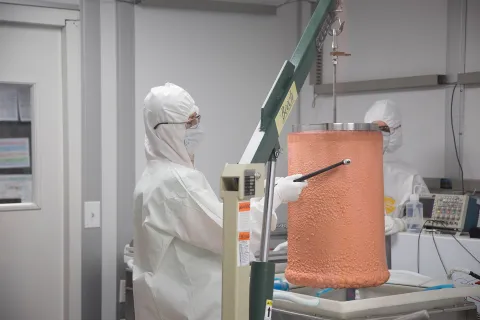
Much of the experiment’s copper is processed underground to remove both natural radioactivity (such as thorium and uranium) and radioactivity generated above ground when cosmic rays strike the copper. Electroforming relies on an electroplating process that over several years forms the world’s purest copper stock. Ultrapure copper is dissolved in acid and electrolytically forms a centimeter-thick plate around a cylindrical stainless-steel mandrel. Any radioactive impurities are left behind in the acid. Here collaborator Cabot-Ann Christofferson of the South Dakota School of Mines & Technology measures the thickness of copper pulled from an electroforming bath. Credit: Sanford Underground Research Facility; photographer Adam Gomez
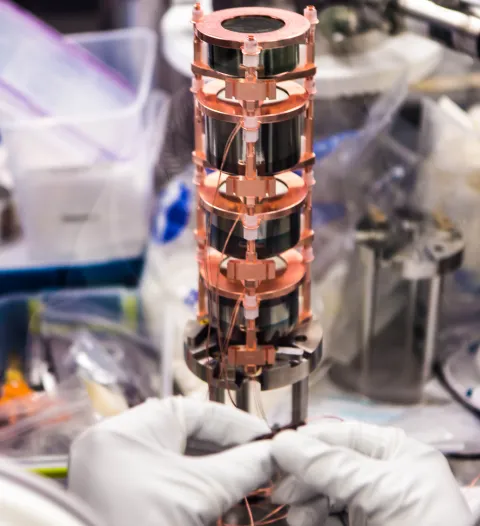
One string of detectors is shown. Parts made of the world’s purest copper hold the detectors together. The experiment’s first batch of detectors was made of natural germanium. Those detectors were uniformly 0.6 kg. Subsequent batches of detectors were enriched in Ge-76, the isotope that undergoes double-beta decay, and varied in height and mass from that of a hockey puck (0.5 kg) to that of a coffee mug (1.1 kg). Credit: Sanford Underground Research Facility; photographer Matthew Kapust
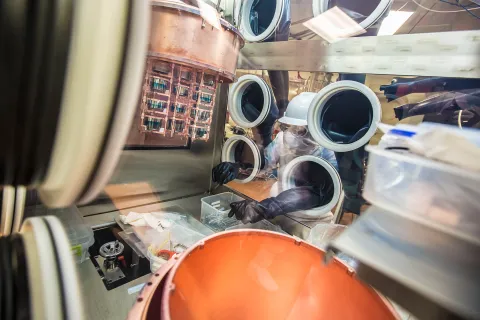
John Wilkerson installs the germanium detector strings into the cryostat. Each string shown here includes four detectors. The strings are configured to fit within the copper cylinder of a cryostat. Of the Majorana Demonstrator’s 44 kilograms of detectors, 30 kg are “enriched” (~88 percent Ge-76) and 14 kg “natural” (~8 percent Ge-76). “It is only from the 30 kg that we search for our signal,” Jason Detwiler said. Credit: Sanford Underground Research Facility; photographer Matthew Kapust
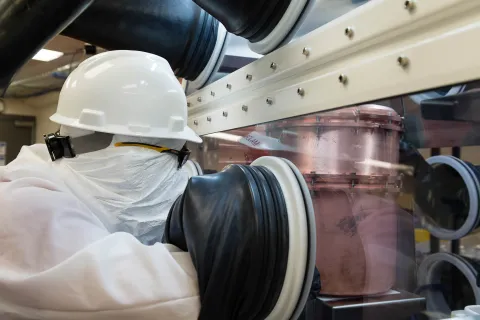
Germanium is a semiconductor like silicon but must operate at approximately minus 200 degrees Celsius. Using a nitrogen-gas-filled glove box to keep components clean, Matthew Green of North Carolina State University and ORNL places detector assemblies in a cryostat where liquid nitrogen under vacuum provides an ultracold environment. Credit: Sanford Underground Research Facility; photographer José Francisco Salgado
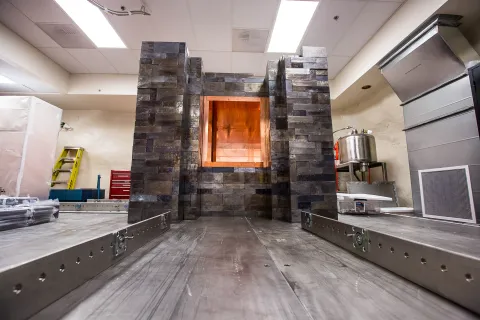
Majorana’s multi-layered shield, which weighs 51,600 kg. Credit: Sanford Underground Research Facility; photographer Matthew Kapust"Lead bricks and copper make up the innermost layers of Majorana’s multi-layered shield, which weighs 51,600 kg. Credit: Sanford Underground Research Facility; photographer Matthew Kapust
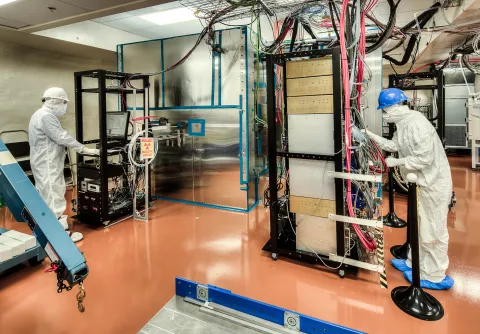
Two cryostats of electroformed copper house germanium detector arrays. A multi-layered shield, within the aluminum enclosure in the back of the room, protects the cryostat" John Wilkerson (left) and Cabot-Ann Christofferson monitor the Majorana Demonstrator. Two cryostats of electroformed copper house germanium detector arrays. A multi-layered shield, within the aluminum enclosure in the back of the room, protects the cryostats. Polyethylene slows ambient neutrons from the rock walls, whereas plastic “veto” panels detect cosmic muons that penetrate the Earth to the depth of the laboratory. An aluminum layer flushed with nitrogen gas keeps out room air, a source of radon gas. A fortress of 4,100 lead bricks blocks gamma rays. A box of ultrapure copper surrounds a two-inch thick layer of electroformed copper to provide extra protection from gamma rays. Credit: Sanford Underground Research Facility; photographer Matthew Kapust